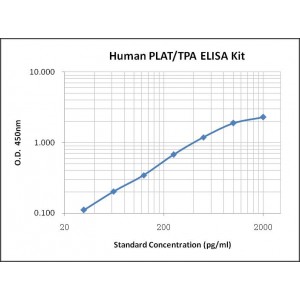More info
Assay Range | 31.2-2,000 pg/mL |
Sensitivity | 10.0 pg/mL |
Specificity | No cross-reaction with other related substances detected |
Size | 96T |
Storage | Store at 2 - 8ºC. Keep reconstituted standard and detection Ab at -20 ºC |
Assay Principle | Sandwich ELISA |
Sample Volume | 100 µL final volume, dilution factor varies on samples |
Sample Type | serum, plasma or cell culture supernatant |
Detection Method | Chromogenic |
Kit Components
1. Recombinant Human PLAT standard: 2 vials
2. One 96-well plate coated with Human PLAT Ab
3. Sample diluent buffer: 12 mL - 1
4. Detection antibody: 130 µL, dilution 1:100
5. Streptavidin-HRP: 130 µL, dilution 1:100
6. Antibody diluent buffer: 12 mL x1
7. Streptavidin-HRP diluent buffer: 12 mL x1
8. TMB developing agent: 10 mL x1
9. Stop solution: 10 mL x1
10. Washing solution (20x): 25 mL x1
Background
Tissue plasminogen activator (tPA or PLAT), is a secreted serine protease synthesized by endothelial cells. Human PLAT is composed of an N-terminal fibronectin type 1 domain, an epidermal growth factor-like domain, two kringle domains and a serine protease catalytic domain. The partially active single chain can be further processed to fully active chain A and chain B which form a Heterodimer. Plasmin, tissue kallikrein or Factor Xa is responsible for the proteolytic cleavage. Active PLAT converts plasminogen to plasmin, the major enzyme required for clot breakdown, by hydrolyzing an Arg-Val peptide bond in plasminogen. Generally, high levels of PLAT can result in excessive bleeding, and low levels of PLAT can result in thrombosis or embolism. Clinically, PLAT is used to treat embolic or thrombotic stroke. PLAT can also bind to fibrin to significantly increase in the catalytic efficiency of PLAT or bind to heparin to promote the activation of plasminogen. In addition, PLAT can bind to annexin A2, cytokeratin-8, fibronectin, laminin, mannose receptor and the low-density lipoprotein receptor-related protein (LRP1) which play a role in PLAT clearance.


